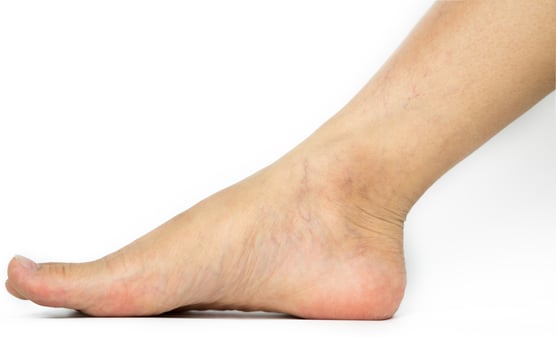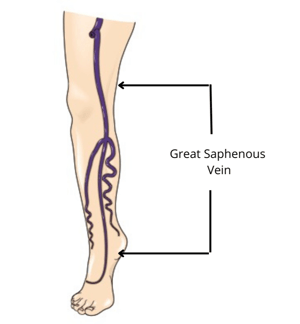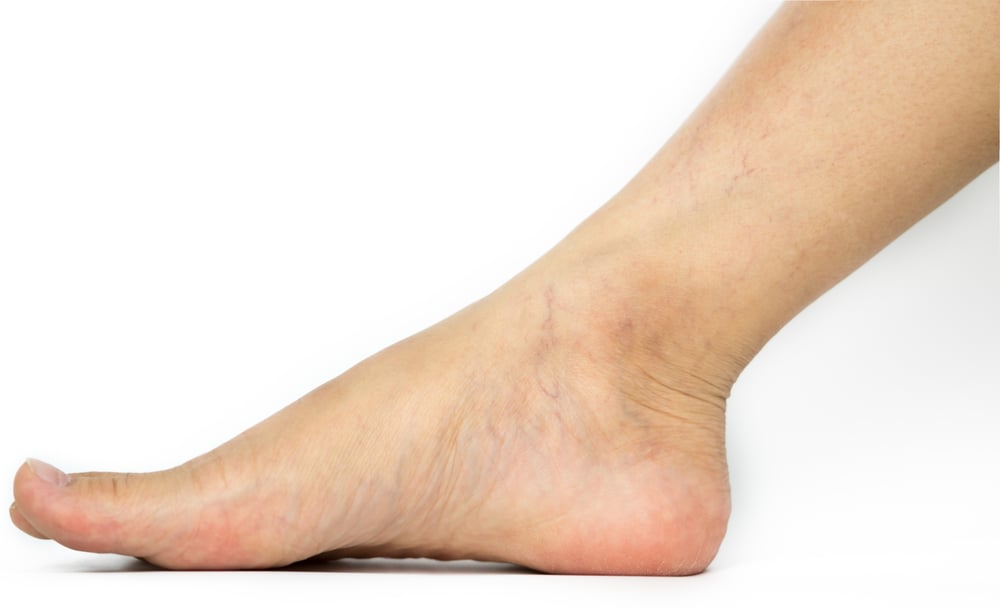Understanding Spider Veins Around the Ankles | Missouri Vein Clinic

Spider veins around your ankles are more than just a cosmetic concern—they're valuable diagnostic indicators. As tiny visible webs of red, purple, or blue veins appear beneath the skin's surface, they tell an important story about your vascular health that can guide effective treatment.
Those unsightly tiny visible webs of spider veins around your ankles may not be welcome when they appear. The information they reveal about what is happening beneath the surface of the skin is key to treating them. From my perspective as a vascular surgeon, the presence of spider veins around the ankles tells me 2 things. 1) There is vein reflux, and 2) which vein, the great or small saphenous vein, is the problem.
Spider veins are the swelling of tiny veins. These veins engorge with blood because of vein reflux. When blood pools in the main veins of the legs, it also affects the connected veins which swell and become visible beneath the surface of the skin. Spider veins can be red, purple, or blue and may be visible all over the legs: the thighs, the back of the knees, and around the ankles. They may vary also in size: some spider veins are readily visible, and others are extremely tiny and more subtle.
Regardless of how they appear, they in and of themselves aren't dangerous, but they do give us helpful information on what might be causing them and what to do about it.
The Hidden Messages of Spider Veins
When those small veins become visible around your ankles, they're communicating two critical pieces of information to vascular specialists:
1. Spider Veins are a Sign of Vein Reflux
Spider veins appear when there is an abnormal flow of circulation in the veins. When there is a problem with blood circulation in the lower legs, blood pools and exerts pressure on the veins. Typically, there are often additional symptoms that are common with a vein condition that you will notice. Things like: fatigue, swelling, aching, cramps, burning, and stinging. Our checklist for invisible signs of a vein condition will help you identify additional symptoms you may be experiencing.
2. The Location of Spider Veins Reveals Which Vein is the Problem
The precise position of spider veins around your ankles serves as a map to the underlying issue:
- Inside Ankle Bone Spider Veins: These indicate reflux in the great saphenous vein—the longest vein in your body, running from your groin down the inner thigh, past the knee, to the inside of your ankle.

- Outside Ankle Spider Veins: These reveal reflux in the small saphenous vein, which travels from behind your knee along the outside of your calf down to the outside ankle.
Spider veins around your ankles are more than just a cosmetic concern—they're valuable diagnostic indicators. As tiny visible webs of red, purple, or blue veins appear beneath the skin's surface, they tell an important story about your vascular health that can guide effective treatment.
The Cosmetic Reality of Spider Veins
Let's be honest—spider veins are simply unattractive. These webbed networks of visible veins can make many people self-conscious about wearing shorts, skirts, or sandals that expose their ankles. While often dismissed as merely a sign of aging, spider veins aren't exclusive to those in their 70s or beyond. They can appear in adults of all ages, even teenagers and those in their 20s. Don't make the mistake of ignoring them just because you're younger or because your symptoms seem minimal now. These visible markers indicate an underlying vein condition that typically worsens over time, with symptoms that can gradually intensify and eventually impact your overall quality of life, affecting everything from your sleep to your ability to stand comfortably for long periods.
Beyond Visibility: Associated Symptoms
Spider veins rarely appear in isolation. If you notice these visible signs, you may also experience:
- Fatigue in your legs
- Swelling, particularly after long periods of standing
- Aching or throbbing sensations
- Muscle cramps, especially at night
- Burning or stinging feelings
- Restless legs
These symptoms, combined with visible spider veins, create a comprehensive picture of your vein health that helps specialists determine the most appropriate treatment approach.
Why Treatment Matters
While spider veins themselves aren't dangerous, they serve as early warning signs of underlying vascular issues that may progress if left untreated. Modern treatments can not only improve the appearance of spider veins but also address the root cause—vein reflux—providing relief from uncomfortable symptoms and potentially preventing progression to more serious venous conditions.
The good news is that with proper diagnosis and targeted treatment, both the visible spider veins and the uncomfortable symptoms they accompany can be effectively addressed, helping you regain comfort and confidence.
If you notice spider veins around your ankles, consider it your body's way of suggesting it's time for a vascular health check. A free screening can identify the specific vein causing the issue and determine the most effective treatment approach for your individual needs.


